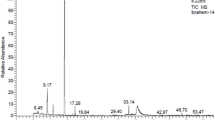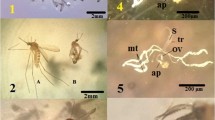Abstract
Oils of Carapa guianensis and Copaifera spp. are well-known in the Amazonian region as natural insect repellents, and studies have reported their efficiency as larvicide against some mosquito species. However, toxicity persistence and effect on mosquito development have not yet been evaluated. Thus, the objective of this study was to evaluate the initial time of larvicidal activity, residual effect, and the effect of very low concentrations of these oils on Aedes aegypti. Different concentrations of the oils were used to evaluate the initial time of larval mortality and residual effect, as well as, the development of larvae, pupae, and adults. Results demonstrated that the lethal effect started mainly between the first 2 and 3 h of larvae exposure to oils, when using concentrations which ranged from 500 mg/L of C. guianensis and 90 mg/L of Copaifera sp. The toxic effect remained with total efficiency (100% mortality) until the sixth day for Copaifera sp. and 12th day for C. guianensis. When using sublethal dosages (ranging from 140 mg/L of C. guianensis to 26 mg/L of Copaifera sp.) mortality was observed after the larval molt. Also, imperfection of pupae and adult development and unsuccessful emergence of adults were observed. A product of botanical origin that could break the development of immature stage of mosquitoes and inhibit the emergence of adults should be essential in vector control. Thus, our results provide new information for a better understanding in using C. guianensis and Copaifera sp. oils with a potential to be used as a natural insecticide.





Similar content being viewed by others
References
Al-Sharook Z, Balan K, Jiang Y, Rembold H (1991) Insect growth inhibitors from two tropical meliaceae. Effects of crude seed extracts on mosquito larvae. J Appl Entomol 111:425–430
Amer A, Mehlhorn H (2006a) Larvicidal effects of various essential oils against Aedes, Anopheles, and Culex larvae (diptera, culicidae). Parasitol Res 99:466–472
Amer A, Mehlhorn H (2006b) Persistency of larvicidal effects of plant oil extracts under different storage conditions. Parasitol Res 99:473–477
Banerji B, Nigam SK (1984) Wood constituents of Meliaceae: a review. Fitoterapia 55:3–36
Chaithong U, Choochote W, Kamsuk K, Jitpakdi A, Tippawangkosol P, Chaiyasit D, Champakaew D, Tuetun B, Pitasawat B (2006) Larvicidal effect of pepper plants on Aedes aegypti (L.) (diptera: culicidae). J Vector Ecol 31:138–144
Cheng SS, Chang HT, Lin CY, Chen PS, Huang CG, Chen WJ, Chang ST (2009) Insecticidal activities of leaf and twig essential oils from Clausena excavata against Aedes aegypti and Aedes albopictus larvae. Pest Manag Sci 65(3):339–343
Choochote W, Tuetun B, Kanjanapothi D, Rattanachanpichai E, Chaithong U, Chaiwong P, Jitpakdi A, Tippawangkosol P, Riyong D, Pitasawat B (2004) Potential of crude seed extract of celery, Apium graveolens L., against the mosquito Aedes aegypti (L.) (diptera: culicidae). J Vector Ecol 29:340–346
Elango G, Rahuman AA, Kamaraj C, Bagavan A, Zahir AA (2010) Efficacy of medicinal plant extracts against malarial vector, Anopheles subpictus Grassi. Parasitol Res 107:1337–1349
Evergetis E, Michaelakis A, Kioulos E, Koliopoulos G, Haroutounian AS (2009) Chemical composition and larvicidal activity of essential oils from six apiaceae family taxa against the West Nile virus vector Culex pipiens. Parasitol Res 105(1):117–124
Finney DJ (1971) Probit analysis, 3rd edn. Cambridge University Press, Cambridge
Geris R, Silva IG, Silva HH, Barison A, Rodrigues-Filho E, Ferreira AG (2008) Diterpenoids from Copaifera reticulata Ducke with larvicidal activity against Aedes aegypti (L.) (diptera, culicidae). Rev Inst Med Trop Sao Paulo 50(1):25–28
Gilbert BDF, Carvalho ES, De Paula AE, Pereira JF, Ferreira JL, Almeida MB, Machado RS, Cascon V (1999) Activities of the Pharmaceutical Technology Institute of the Oswaldo Cruz Foundation with medicinal, insecticidal and insect repellent plants. An Acad Bras Ci 7l:265–27t
Herrero-Jáuregui C, Casado MA, das Graças Bichara Zoghbi M, Célia Martins-da-Silva R (2011) Chemical variability of Copaifera reticulata Ducke oleoresin. Chem Biodivers 8(4):674–685
Jayaprakasha GK, Singh RP, Pereira J, Sakariah KK (1997) Limonoids from Citrus reticulata and their moult inhibiting activity in mosquito Culex quinquefasciatus larvae. Phytochemistry 44:843–846
Kamaraj C, Rahuman AA, Mahapatra A, Bagavan A, Elango G (2010) Insecticidal and larvicidal activities of medicinal plant extracts against mosquitoes. Parasitol Res 107(6):1337–1349
Karmegam N, Sakthivadivel M, Anuradha V, Daniel T (1997) Indigenous plant extracts as larvicidal agents against Culex quinquefasciatus Say. Bioresour Technol 59:137–140
Kerah-Hinzoumbé C, Péka M, Nwane P, Donan-Gouni I, Etang J, Samè-Ekobo A, Simard F (2008) Insecticide resistance in Anopheles gambiae from south-western Chad, Central Africa. Malar J 29(7):192
Marcombe S, Carron A, Darriet F, Etienne M, Agnew P, Tolosa M, Yp-Tcha MM, Lagneau C, Yébakima A, Corbel V (2009) Reduced efficacy of pyrethroid space sprays for dengue control in an area of Martinique with pyrethroid resistance. Am J Trop Med Hyg 80(5):745–751
Mendonça FA, Silva KF, Santos KK, Ribeiro KA, Sant'Ana AE (2005) Activities of some Brazilian plants against larvae of the mosquito Aedes aegypti. Fitoterapia 76:629–636
Murugan K, Babu R, Jeyabalan D, Kumar NS, Sivaramakrishnan S (1996) Antipupational effect of neem oil and neem seed kernel extract against mosquito larvae of Anopheles stephensi (Liston). J Entomol Res 20:137–139
Pontes RJ, Regazzi AC, Lima JW, Kerr-Pontes LR (2005) Residual effect of commercial applications of larvicides temefos and Bacillus thuringiensis israelensis on Aedes aegypti larvae in recipients with water renewal. Rev Soc Bras Med Trop 38(4):316–321
Pontes RJS, Dantas Filho FF, Alencar CHM, Regazzi ACF, Cavalcanti LPG, Ramos AN, Lima JWO (2010) Impact of water renewal on the residual effect of larvicides in the control of Aedes aegypti. Mem Inst Oswaldo Cruz 105:220–224
Prophiro JS, Silva OS, Luna JE, Piccoli CF, Kanis LA, Silva MA (2011) Aedes aegypti and Aedes albopictus (Diptera: Culicidae): coexistence and susceptibility to temephos, in municipalities with occurrence of dengue and differentiated characteristics of urbanization. Rev Soc Bras Med Trop (in press)
Sakthivadivel M, Thilagavathy D (2003) Larvicidal and chemosterilant activity of the acetone fraction of petroleum ether extract from Argemone mexicana L. seed. Bioresour Technol 89:213–216
Sarkar M, Bhattacharyya IK, Borkotoki A, Goswami D, Rabha B, Baruah I, Srivastava RB (2009) Insecticide resistance and detoxifying enzyme activity in the principal bancroftian filariasis vector, Culex quinquefasciatus, in northeastern India. Med Vet Entomol 23(2):122–131
Saxena SC, Sumithra L (1985) Laboratory evaluation of leaf extract of a new plant to suppress the population of malaria vector Anopheles stephensi Liston (diptera: culicidae). Curr Sci 54:201–202
Seccacini E, Lucia A, Zerba E, Licastro S, Masuh H (2008) Aedes aegypti resistance to temephos in Argentina. J Am Mosq Control Assoc 24(4):608–609
Shaalan EAS, Canyon DV, Younes MWF, Wahab HA, Mansour AH (2005) Effects of sub-lethal concentrations of synthetic insecticides and Callitris glaucophylla extracts on the development of Aedes aegypti. J Vector Ecol 30:295–298
Shanmugasundaram R, Jeyalakshmi T, Dutt MS, Murthy PB (2008) Larvicidal activity of neem and karanja oil cakes against mosquito vectors, Culex quinquefasciatus (say), Aedes aegypti (L.) and Anopheles stephensi (L.). J Environ Biol 29(1):43–45
Silva IG, Zanon VOM, Silva HHG (2003) Larvicidal activity of Copaifera reticulata ducke oil-resin against Culex quinquefasciatus Say (diptera: culicidae). Neotrop Entomol 32:729–732
Silva OS, Romão PR, Blazius RD, Prophiro JS (2004) The use of andiroba Carapa guianensis as larvicide against Aedes albopictus. J Am Mosq Control Assoc 20:456–457
Silva OS, Prophiro JS, Rossi JCN, Kanis LA, Romão PRT, Blazius RD (2006) Larvicidal effect of andiroba oil Carapa guianensis (Meliaceae) against Aedes aegypti (diptera: culicidae). J Am Mosq Control Assoc 22:699–701
Silva HHG, Geris R, Rodrigues E, Rocha C, Silva IG (2007) Larvicidal activity of oil-resin fractions from the Brazilian medicinal plant Copaifera reticulata Ducke (leguminosae-caesalpinoideae) against Aedes aegypti (diptera, culicidae). Rev Soc Bras Med Trop 40:264–267
Silva WJ, Dória GA, Maia RT, Nunes RS, Carvalho GA, Blank AF, Alves PB, Marçal RM, Cavalcanti SC (2008) Effects of essential oils on Aedes aegypti larvae: alternatives to environmentally safe insecticides. Bioresour Technol 99:3251–3255
Taylor DAH (1984) The chemistry of the limonoids from Meliaceae. Fort Chem Org Naturst 45:1–102
Veiga Junior VF, Rosas EC, Carvalho MV, Henriques MGMO, Pinto AC (2007) Chemical composition and antiinflammatory activity of copaiba oils from Copaifera cearensis Huber ex Ducke, Copaifera reticulata Ducke and Copaifera multijuga Hayne—a comparative study. J Ethnopharmacol 112:248–254
WHO (1981a) Instructions for determining the susceptibility or resistance of mosquito larvae to insecticides. WHO, Geneva
WHO (1981b) Criteria and meaning of tests for determining the susceptibility or resistance of insects to insecticides. WHO, Geneva
Wiesman Z, Chapagain BP (2006) Larvicidal activity of saponin containing extracts and fractions of fruit mesocarp of Balanites aegyptiaca. Fitoterapia 77(6):420–424
Yadav S, Mittal PK, Saxena PN, Singh RK (2008) Effect of synergist piperonyl butoxide (PBO) on the toxicity of some essential oils against mosquito larvae. J Commun Dis 40(4):263–268
Yewhalaw D, Wassie F, Steurbaut W, Spanoghe P, Van Bortel W, Denis L, Tessema DA, Getachew Y, Coosemans M, Duchateau L, Speybroeck N (2011) Multiple insecticide resistance: an impediment to insecticide-based malaria vector control program. PLoS One 6(1):e16066
Zhu J, Zeng X, O'Neal M, Schultz G, Tucker B, Coats J, Bartholomay L, Xue RD (2008) Mosquito larvicidal activity of botanical-based mosquito repellents. J Am Mosq Control Assoc 24(1):161–168
Acknowledgments
The authors acknowledge the support from the National Council of Research and Development (CNPq) which provided funds for the project process 410579/2006-8 and scholarship.
Author information
Authors and Affiliations
Corresponding authors
Rights and permissions
About this article
Cite this article
Prophiro, J.S., da Silva, M.A.N., Kanis, L.A. et al. Evaluation of time toxicity, residual effect, and growth-inhibiting property of Carapa guianensis and Copaifera sp. in Aedes aegypti . Parasitol Res 110, 713–719 (2012). https://doi.org/10.1007/s00436-011-2547-5
Received:
Accepted:
Published:
Issue Date:
DOI: https://doi.org/10.1007/s00436-011-2547-5




